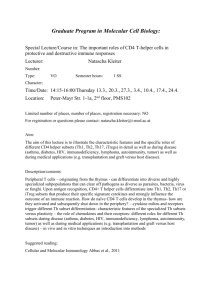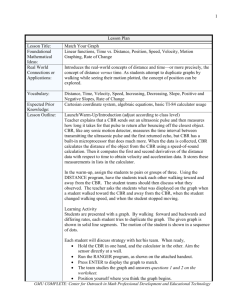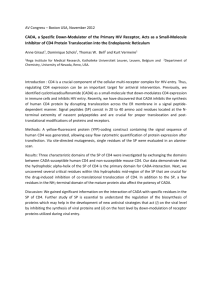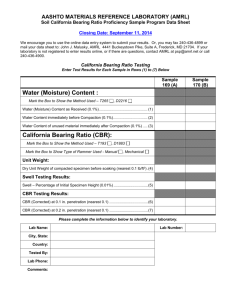Proposed log-frame for implementation By Istvan Patkai and Andrew
advertisement
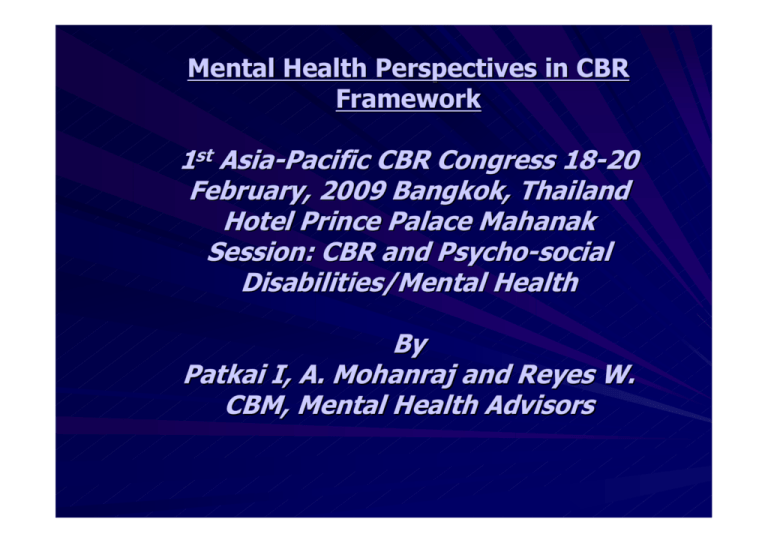
Mental Health Perspectives in CBR Framework 1st Asia-Pacific CBR Congress 18-20 February, 2009 Bangkok, Thailand Hotel Prince Palace Mahanak Session: CBR and Psycho-social Disabilities/Mental Health By Patkai I, A. Mohanraj and Reyes W. CBM, Mental Health Advisors Outline –A1. Introduction 2. Discussion ¾ 2.1. Empowerment of service users and carers ¾ 2.2. Management 3. Proposed Matrix for CBR Guidelines Outline –B- 4. Mental health perspectives ¾ 4.1. Empowerment Domain 4.1.1. Mental health promotion, attitudes, values, principles 4.1.2. Packages for teambuilding, care for the carers, manage burnout ¾ 4.2. Health Domain 4.2.1. Old systems of care - Human rights violations 4.2.2. Good practices 5. Conclusions 6. References 1. Introduction CBR strategies have constantly undergone refinement and changes The Helsinki mandate validated the evolving concept in 1994 In 2004 the WHO proposed a matrix for the guidelines of CBR work Implementers were reminded that the matrix is not sequential. Special focus on key elements of the matrix will ensure a holistic and comprehensive approach 2. Discussion Motto “One camel does not make fun of the other camel’s hump” - Guinean proverb ¾ 2.1. Empowerment of service users and carers ¾ 2.2. Management 2.1. Empowerment of service users and carers –ABurnout of aid workers is often overlooked, neglected and aid workers are demoralized Care givers must recognize their own fallibility; they are “wounded healers” Objectives, values and principles are connecting the service users and the care givers 2.1. Empowerment of service users and carers -BEmpowered service users and families work together with committed care givers “Wounded healers” - professionals and lay caring persons share their dreams, visions, core - values, principles, attitudes, theories with service users Work on stress theory, burnout, helping styles, team building; internalize principles of inclusion, accessibility, communication, participation, etc. Shift empowerment domain to the top of the Matrix CBR GUIDELINES CBR MATRIX Empowerment of service users and carers - Values and principles Management - Coordination and leadership - Contextualization of core values/principles/management Health Education Livelihood Social 2.2. Management -A‘The key priority for any policy framework, planning or implementation in CBR should be to prioritize technical, organizational, administrative, and personnel management including strategic leadership issues’ – Kuipers at al Leadership to be empowered with management, social and communication skills Implement positive attitudes and values of care givers and consumers in PCM strategies 2.2. Management -BWhen we join hands we need coordination – management as well as protection for the service users and also for the care givers’ safety, dignity, security Accept responsibilities in the existing legal environment and set goals and objectives; follow Project Cycle Management Shift management domain to follow the empowerment in the Matrix CBR GUIDELINES CBR MATRIX Empowerment of service users and carers - Values and principles Management - Coordination and leadership - Contextualization of core values/principles/management Health Education Livelihood Social 3.1. Contextualization of core values/principles and management Contextualize our commitment and management skills in NGOs and governmental organizations on the domains of Health Education Livelihood and Social 3. CBR GUIDELINES CBR MATRIX Empowerment of service users and carers - Values and principles Management - Coordination and leadership - Contextualization of core values/principles/management Health Education Livelihood Social 4. Mental health perspectives –A¾ 4.1. Empowerment Domain 4.1.1. Mental health promotion, attitudes, values, principles 4.1.2. Packages for teambuilding, care for the carers, manage burnout 4. Mental health perspectives –B¾ 4.2. Health Domain 4.2.1. Old system of care - Human rights violations 4.2.2. Good practices 5. Conclusions -AThe “Guidelines are living documents”, indeed “not a prescriptive step by step guide”, but “common principles and themes make it comprehensive, illustrating practical up-to-date strategies” - CBR Guidelines Our notes are reflections on developing a comprehensive strategy, a logical framework with especial emphasis on roles and place of mental health. 5. Conclusions -BI am about to conclude our address and I feel that it is appropriate for me to say some inspirational words. ´I would like to have in my hands the remedy for the needs of the service users, but often that is not the case. As your brother, I say to you that I try to share your pain. Do not feel alone. I prepare myself to accompany you all your life if your suffering requires that. And to you my sisters and brothers in the various serving ministries I would say that for the good of those who suffer, let us live our vocation to its fullest. There is no greater vocation than that of helping the human person to be more human.’ 6. References 1. 2. 3. 4. 5. 6. 7. 8. 9. 10. 11. 12. 13. 14. 15. Fountain, D. E., 1989, Health, the Bible, and the Church, Billy Graham Centre, Wheaton College, USA. Hospitaller Order of Saint John of God, 1993, Reaching Out, Mental Health Service Policy, 1993 Colwill, R. 1994, Annual Report for 1994, A report prepared for the Christoffel Blindenmission, Methodist Church Nigeria Amaudo Itambauzo Centre for mentally Ill Destitutes. Wiebe, B. 1987, The Ministry of Presence, MMM, Oct./Nov./Dec., 1987 Falloon, I.R.H. and Fadden, G. 1993, Integrated Mental Health Care, Cambridge University Press, Great Britain Conrad, P. L. 1987, In Wiebe, B. 1987, How much do you care? Mennonite Medical Messenger, October- December, 1987, 38: 4 Prashantham, B. J. 1988, Indian Case Studies in Therapeutic Counseling Christian Counseling Centre, Vellore, India Augsburger, D. W., 1986, Pastoral Counseling Across Cultures, The Westminster Press, Philadelphia, Pennsylvania, USA Kipp, J. 1987, The Closing Prayer was inspired by Kipp, J., 1987, (This prayer was used as part of a worship service led by Jim World Health Organization, CBR Guidelines, 2008 Thara R, R. Padmavati, J.R. Aynkran and Sujit J: Community mental health in India: A rethink. International Journal of Mental Health Systems 2008, 2:11 United Nations, Convention on the Rights of Persons with Disabilities, New York, 2008, (http://www.who.int/hpr/NPH/declaration_almaata.pdf, accessed 10 May, 2008 Pim Kuipers, Sheila Wirz and Sally Hartley: Systematic synthesis of community-based rehabilitation (CBR) project evaluation reports for evidence-based policy: a proof-ofconcept study. BMC International Health and Human Rights, 2008 8:3 George Christina, “A post disaster intervention emerges into a sustainable community focused mental health program.” DR. S.M.C.S.I Medical College, Karakonam, South India, Draft, 2008 Njenga, F.G. “Challenges of balanced care in Africa”. In World Psychiatry, 1:2 – June 2002 Federal Ministry of Health. “The National Mental Health Policy for Nigeria”. Federal Ministry of Health, Nigeria, 1991.

